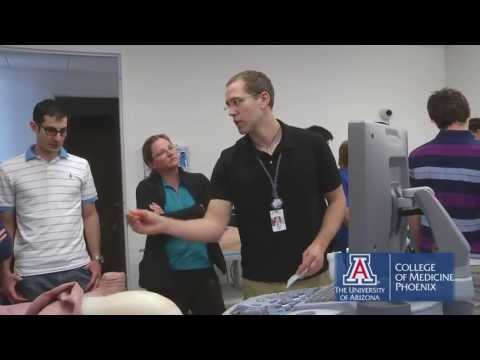Today, we are having a seminar for the graduating fourth-year students to let them have an opportunity to get some hands-on training in ultrasound, which is one of the biggest areas in medicine these days. Almost everywhere, there’s a big rush to incorporate ultrasound into the curriculum, and so that is something that we’re working on right now for the new curriculum. Today, they are learning how to ultrasound a gallbladder, some other intra-abdominal structures, the heart; they are learning how to scan a woman for pregnancy; and they are learning some procedures to learn how to use the ultrasound to guide them into fluid collections and other things, so that when they do a procedure, they’re not going to puncture a lung or hit a blood vessel.
So the ultrasound keeps them out of trouble. Well, the ultrasound, I mean, it’s a very useful tool. I think it was great. We kind of use it in the hospital all the time, so kind of actually practicing on non-real patients is kind of a relief to, you know, realize what you have to use and how to do it, and then when you get to the real patient, you actually know what’s going on, so it’s good. I learned how difficult it is to actually maneuver the ultrasound probe and get the image that you want in the picture. I watch people do it all the time, but very rarely have I been the one that’s actually in charge and usually if I am, I’m looking for something really big, not something small like a little vessel. It’s definitely more fun that being, than sitting in a classroom.
Getting to practice all these procedures and getting to do it in an environment where if you mess up or if you have to poke somebody multiple times it’s not a big deal because it’s a mannequin, rather than a patient that’s screaming and wants nothing to do with you. Today, they’re just getting a taste of what they can do with ultrasound, and ultrasound is becoming so widespread in so many areas of medicine that these young doctors graduating now, for the most part, are going to be using it. It’s not something that is routinely done in most medical schools, and we think it’s very important because imaging is a big part of evaluating and treating patients..
